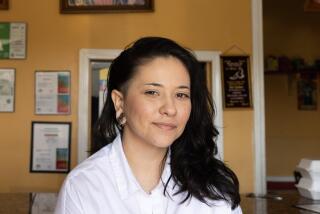Ancient Religious Rite Brings the Filipino Community Together : Like Old Times at Home
- Share via
RANCHO SANTA MARGARITA — They streamed into the modest living room and made the sign of the cross to the statue of the Virgin Mary that stands regally on a mantle draped with white cloth.
Then the 50 or so people knelt on the floor as they sang hymns, prayed and recited the rosary, never taking their eyes off the Blessed Mother.
With the rites finished, the entourage ferried the statue to another house to recite another set of prayers and welcome the Blessed Mother into the home.
But there is more to this gathering than the practice of an ancient religious rite, which dates to the Philippines of the 1600s.
Although its primary purpose is religious, the observance of the rosary tradition by the Federation of Filipino Rosary Groups is a cultural and social tie that binds the 30,000 people of Philippine descent in Orange County.
Through the 26 rosary groups--each consisting of about 50 families--that make up the federation, Filipino Americans nurture their traditions and customs far from their homeland.
“It helps us keep our religion, our values and our family traditions,” said Paz Reyes recently at one of the ceremonies held by the Rancho Santa Margarita rosary group every Friday. “It’s a way for us to feel as if we’re back home.”
Although the Orange County Filipino community is relatively small in number, it is diverse: People hail from various Philippine islands and they owe allegiance to dozens of competing social and political organizations here.
“Filipinos are basically individualistic,” said Father Marito F. Rebamontan, director of the Filipino Pastoral Ministry in the Roman Catholic Diocese of Orange. “Because we come from different islands--each with its own distinct differences, distinct dialects--the distinctions oftentimes are very strong.”
But, Rebamontan added, no matter what their background or native language, the one thing that unites the community is the practice brought from the Philippines, which is 80% Catholic: the prayers of the rosary groups, or “block rosary” as it is known back home.
The recitation of the rosary is intrinsic to the Catholic faith. While clasping a strand of beads, the worshiper says prayers for penance and to pay homage to the Virgin Mary.
Catholics besides Filipinos also have gatherings to recite the rosary, but their get-togethers are mostly private and not as organized and continuous as those of the Filipino rosary groups, church officials said.
The Orange County Federation of Filipino Rosary Groups started in 1985 as a gathering of five families, lonely in their new country and wanting to bring together other Filipinos. The five families formed a chapter of the Los Angeles Federation of Rosary Groups.
In the years since, 1,300 families have become members, allowing the chapter to form its own federation three years ago. And more families join every month, leaders of the different groups said.
Through the weekly rituals--which also spawn retreats, dances, fund-raisers, counseling and youth groups--strangers have become best friends. Long-lost relatives have found each other. Far-flung neighbors have become adopted families.
Two years ago, when her husband had to go to Florida to find employment and she volunteered to work with the Northridge earthquake disaster relief, Reyes appealed to a rosary group “sister” to take care of her two teenage sons.
The woman, Sally Cordova, brought dinner over every evening. For six weeks.
“This sounds superficial but it is the truth,” Cordova said. “In a rosary group, when someone we know has a problem, our hearts also ache; we feel the pain.”
Celia Pancho still cries when she recalls the kindness of the strangers who came to her aid during the darkest hours of her life.
It was May 1993, and her daughter, Mariquita Torio, had been killed in her South County home, leaving behind her two young children. Pancho, who had immigrated to the United States two years before, didn’t know what to do or where to turn for support.
Torio had been a member of the Rancho Santa Margarita rosary group. In the wake of her death, members made sure that her parents and children were never alone, tended to funeral plans, arranged for other family members from the Philippines to come and attend the service and raised money to send Torio’s body back to her homeland for burial.
Furthermore, “they cooked for us and they prayed for us and they comforted us,” recounts Pancho, 59, now of Los Angeles. “I will never forget their kindness.”
The rosary groups also have become something of an employment network for members.
Several years ago, Irene Alzate of Garden Grove bumped into a long-lost friend from college at a group’s retreat. While they were catching up on old times, Alzate told the friend she was looking for a job. Soon after, the woman helped Alzate land her current position as a program coordinator at the Laterman Developmental Center in Diamond Bar.
“The rosary groups have become a communication pipeline,” said Alzate, a founding member of the county’s first rosary group. “People find out what others in the community are doing, who’s sick, who getting married, who needs a job, who can provide one.”
She pauses. “So many functions stemming from so simple and traditional a practice, no?”
More to Read
Sign up for Essential California
The most important California stories and recommendations in your inbox every morning.
You may occasionally receive promotional content from the Los Angeles Times.













